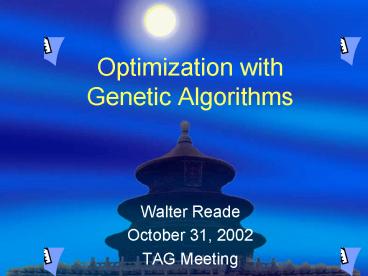Optimization with Genetic Algorithms - PowerPoint PPT Presentation
Title:
Optimization with Genetic Algorithms
Description:
elseif ceil(assignment(i)/4) == family_info(i,3) % second choice ... building = ceil(assignment(i)/4); occupancy(building) = occupancy(building) family_info(i,1) ... – PowerPoint PPT presentation
Number of Views:1090
Avg rating:3.0/5.0
Title: Optimization with Genetic Algorithms
1
Optimization withGenetic Algorithms
- Walter Reade
- October 31, 2002
- TAG Meeting
2
Outline
- Background on Optimization
- Introduction to Genetic Algorithms
- Using GAs to Solve Difficult Problems
- A MatLab Implementation
- Summary / Questions
3
How Do We Find the Minimum?
4
Gradient Methods(Steepest Descent)
- Move in the direction of steepest gradient.
- Simple to implement, guaranteed convergence.
- Must know something about the derivative.
- Can easily get stuck in a local minimum.
5
Stochastic Methods
- Heuristic
- Using Rules of Thumb
- Metaheuristic
- A framework of heuristics used to update a set of
solutions during a search. - Simulated Annealing
- Tabu Search
- Ant Colony Systems
6
Genetic Algorithms
- Use a population of possible solutions to the
search space. - Each solution is encoded in a string called a
chromosome (or genome). - Chromosomes are evaluated for fitness each
generation (iteration) chromosomes that are more
fit have a high probability of surviving.
7
Genetic Algorithms (cont.)
- Once the surviving population is chosen,
different parent chromosomes are combined to
form child chromosomes. - Chromosomes may undergo mutation.
- A new generation is formed, the process is
repeated. - By selection, cross-over, and mutation, GAs
search the solution space while creating stronger
solutions over each generation.
8
Fitness and Selection
- Roulette Wheel
- Competition
- Etc.
9
Cross-Over
- Replaces two parent solutions with two children
solutions. - Mechanism for covering large area of search space.
10
Mutation
- Operates on a single chromosome.
- Mechanism to improve local search space.
11
Advantages to using GAs
- Flexible and adaptive to a wide variety of
problems. - Robust, global search capability.
- Does not require the solution space to be smooth,
continuous, or differentiable. - Can be used in permutation problems.
- No practical drawbacks.
- Slow local convergence
- Perceived learning overhead
12
Applications
- Function optimization
- Job shop scheduling
- Process planning
- Assembly line optim.
- Process control
- Airplane landing
- Nested design
- Keyboard layout
- Creativity
- VLSI
- Traveling Sales Man
- Chemical kinetics
- Etc.
- Etc.
- Etc.
13
Solving Difficult Problems
14
Difficult Problems
- Appeared in Jan/Feb 2002 SIAM News in the
100-Dollar, 100-Digit Challenge. - exp(sin(50x)) sin(60exp(y)) sin(70sin(x))
sin(sin(80y)) - sin(10(xy)) 0.25(x2
y2) - The genetic algorithm was able to solve this to
10 digits of precision in 2000 generations, which
took 25 seconds on a P-III 1.0 GHz. (35 success
rate)
15
Permutation (Order-based) Problems
- Time-share Example
- One condo building at a ski resort
- Four identical condo units
- 16 week ski season 64 total owners
- 2nd choice 2 free lift tickets per person, 3rd
choice 5 free tickets, otherwise and 7 free
tickets. - 5 out of 16 weeks are twice as popular
- Maximum occupancy 22
- Possible solutions 1x1067
16
Results of GA
- A previous published result (using SA) found a
minimum of 224 after 261 iterations, and no
improvement after 1,000,000 iterations. - The GA found a cost of 200 after 2,150
iterations, and a minimum of 172 after 250,000
iterations. - (Author of previous work was astonished at the
new result.)
17
Using GAs in MatLab
- http//www.ie.ncsu.edu/mirage/GAToolBox/gaot/
18
MatLab Code
- Bounds on the variables
- bounds -5 5 -5 5
- Evaluation Function
- evalFn 'Four_Eval'
- evalOps
- Generate an intialize population of size 80
- startPopinitializega(80,bounds,evalFn,1e-10
1) - GA Options epsilon float/binary display
- gaOpts1e-10 1 0
- Termination Operators -- 500 Generations
- termFns 'maxGenTerm'
- termOps 500
- Selection Function
- selectFn 'normGeomSelect'
- selectOps 0.08
- Crossover Operators
- xFns 'arithXover heuristicXover simpleXover'
- xOpts 1 0 1 3 1 0
- Mutation Operators
- mFns 'boundaryMutation multiNonUnifMutation
nonUnifMutation unifMutation' - mOpts 2 0 03 200 32 200 32 0 0
- Apply the genetic algorithm
- soln endPop bestPop tracega(bounds,evalFn,evalO
ps,startPop,gaOpts,termFns,termOps,selectFn,select
Ops,xFns,xOpts,mFns,mOpts)
19
Evaluation Function
- function x, soln Four_Eval(x, options)
- soln -(exp(sin(50x(1))) sin(60exp(x(2)))
sin(70sin(x(1))) ... - sin(sin(80x(2))) - sin(10(x(1)x(2)))
0.25(x(1)2 x(2)2))
20
Time Share Evaluation Function
- function assignment, soln local_min(assignment
, options) - global family_info
- cost 0
- occupancy zeros(16,1)
- for i 164
- if ceil(assignment(i)/4) family_info(i,2)
first choice - cost cost 0
- elseif ceil(assignment(i)/4)
family_info(i,3) second choice - cost cost 2family_info(i,1)
- elseif ceil(assignment(i)/4)
family_info(i,4) third choice - cost cost 4family_info(i,1)
- else didn't get any choice
- cost cost 50 7family_info(i,1)
- end
21
Summary
- Genetic Algorithms are
- Powerful
- Flexible
- Easy to use and understand
- Consider using a GA for your next optimization
problem!
22
(No Transcript)































